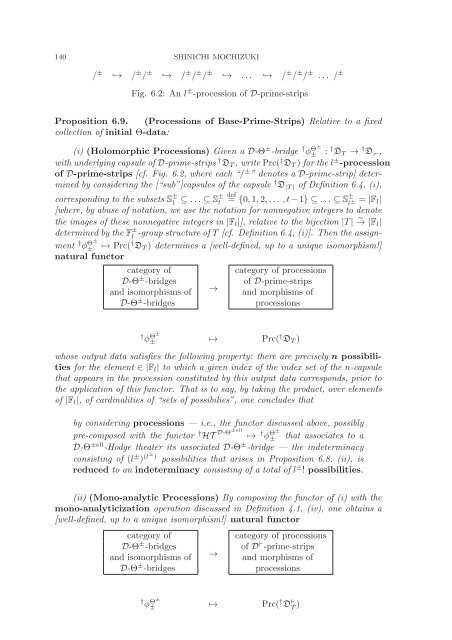Inter-universal Teichmuller Theory I: Construction of Hodge Theaters
Inter-universal Teichmuller Theory I: Construction of Hodge Theaters
Inter-universal Teichmuller Theory I: Construction of Hodge Theaters
You also want an ePaper? Increase the reach of your titles
YUMPU automatically turns print PDFs into web optimized ePapers that Google loves.
140 SHINICHI MOCHIZUKI<br />
/ ± ↩→ / ± / ± ↩→ / ± / ± / ± ↩→ ... ↩→ / ± / ± / ± ... / ±<br />
Fig. 6.2: An l ± -procession <strong>of</strong> D-prime-strips<br />
Proposition 6.9. (Processions <strong>of</strong> Base-Prime-Strips) Relative to a fixed<br />
collection <strong>of</strong> initial Θ-data:<br />
(i) (Holomorphic Processions) Given a D-Θ ± -bridge † φ Θ±<br />
± : † D T → † D ≻ ,<br />
with underlying capsule <strong>of</strong> D-prime-strips † D T , write Prc( † D T ) for the l ± -procession<br />
<strong>of</strong> D-prime-strips [cf. Fig. 6.2, where each “/ ± ” denotes a D-prime-strip] determined<br />
by considering the [“sub”]capsules <strong>of</strong> the capsule † D |T | <strong>of</strong> Definition 6.4, (i),<br />
corresponding to the subsets S ± 1 ⊆ ...⊆ S± def<br />
t = {0, 1, 2,... ,t−1} ⊆...⊆ S ± l<br />
= |F ± l |<br />
[where, by abuse <strong>of</strong> notation, we use the notation for nonnegative integers to denote<br />
the images <strong>of</strong> these nonnegative integers in |F l |], relative to the bijection |T | →|F ∼ l |<br />
determined by the F ± l<br />
-group structure <strong>of</strong> T [cf. Definition 6.4, (i)]. Then the assignment<br />
† φ Θ±<br />
± ↦→ Prc( † D T ) determines a [well-defined, up to a unique isomorphism!]<br />
natural functor<br />
category <strong>of</strong><br />
D-Θ ± -bridges<br />
and isomorphisms <strong>of</strong><br />
D-Θ ± -bridges<br />
→<br />
category <strong>of</strong> processions<br />
<strong>of</strong> D-prime-strips<br />
and morphisms <strong>of</strong><br />
processions<br />
† φ Θ±<br />
± ↦→ Prc( † D T )<br />
whose output data satisfies the following property: there are precisely n possibilities<br />
for the element ∈|F l | to which a given index <strong>of</strong> the index set <strong>of</strong> the n-capsule<br />
that appears in the procession constituted by this output data corresponds, prior to<br />
the application <strong>of</strong> this functor. That is to say, by taking the product, over elements<br />
<strong>of</strong> |F l |, <strong>of</strong> cardinalities <strong>of</strong> “sets <strong>of</strong> possibilies”, one concludes that<br />
by considering processions — i.e., the functor discussed above, possibly<br />
pre-composed with the functor † HT D-Θ±ell ↦→ † φ Θ±<br />
± that associates to a<br />
D-Θ ±ell -<strong>Hodge</strong> theater its associated D-Θ ± -bridge — the indeterminacy<br />
consisting <strong>of</strong> (l ± ) (l±) possibilities that arises in Proposition 6.8, (ii), is<br />
reduced to an indeterminacy consisting <strong>of</strong> a total <strong>of</strong> l ± ! possibilities.<br />
(ii) (Mono-analytic Processions) By composing the functor <strong>of</strong> (i) with the<br />
mono-analyticization operation discussed in Definition 4.1, (iv), one obtains a<br />
[well-defined, up to a unique isomorphism!] natural functor<br />
category <strong>of</strong><br />
D-Θ ± -bridges<br />
and isomorphisms <strong>of</strong><br />
D-Θ ± -bridges<br />
→<br />
category <strong>of</strong> processions<br />
<strong>of</strong> D ⊢ -prime-strips<br />
and morphisms <strong>of</strong><br />
processions<br />
† φ Θ±<br />
± ↦→ Prc( † D ⊢ T )
















